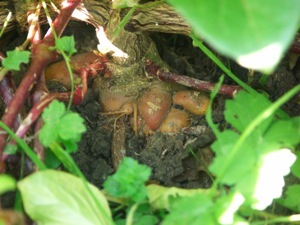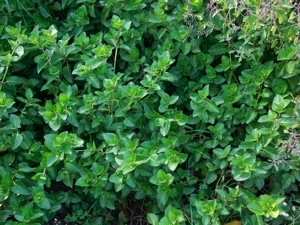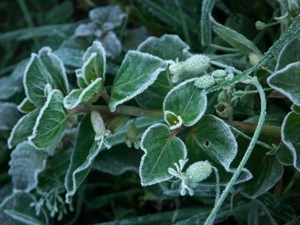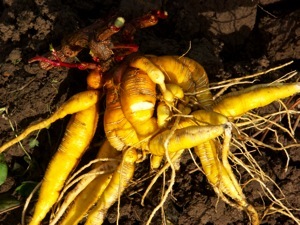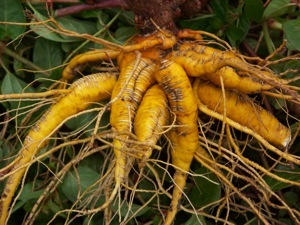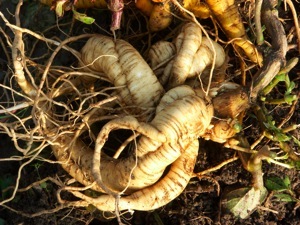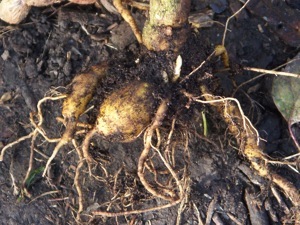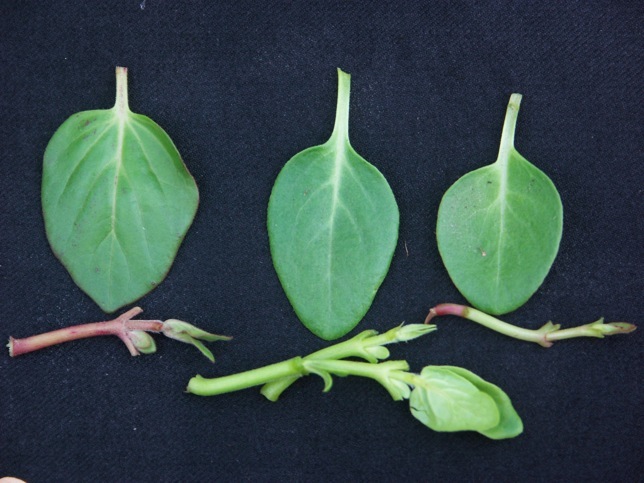
Mauka
Mauka (mirabilis expansa) is an old vegetable grown by the Incas. It was believed that the Mauka had disappeared, until the 1960s. At that time a few families were found that still grew out this Mauka, first in Bolivia, after that it was also discovered in Peru and Ecuador. In these small communities where the culture of maukas still existed, there were also several varieties: yellow, orange, ... and almost as many local names: Mauka, chago, yuca, ... The most common name is still Mauka, used mainly in Bolivia and parts of Peru.
The Mauka is traditionally grown in the Andes, at altitudes of at least 2300 meters to 3800 meters or more. It is found almost exclusively in small family gardens, together with corn, potatoes, ocas or ullucos ,.... To my knowledge they aren't not grown in the fields, but maybe there might be some small places where maukas are integrated into the mixed culture (mostly Mashua, potatoes, oca and ulluco) used by Andean farmers.
Mauka has many edible uses: you can eat the leaves (cooked like spinach or raw in salads), stems (cooked) and (especially) roots. These roots can become very large, up to 40 cm. long and 8 cm. in diameter. They are propagated mainlyby cuttings, but sowing is also possible.
I obtained some of these vere rare seeds and they were sown on March 27. These seeds need light to germinate well,so they were placed on top of small pots filled with sterilized compost. These small pots were placed in the greenhouse, average temperature during the day at that time ranged from 18-29 degrees; during the night from -2 to 11 degrees. Germinating maukas seems to be somewhat comparable to germination of other Andean tuber temperatures , they prefer 20-23 ° C during the day, 7-9 ° C during the night. Given the very low temperatures, I had to protect maukas for a few nights (the foliage does freeze). The first small leaves appeared after 12 days. A total of 6 small Maukas did germinate, one did not survive. The percentage of germination was poor: 30% for the first variety, 0% for the second ... These small plants were growing very well, a bit slow at first, but that is normal for such small plants. Three weeks after germination, stems had a length of more than twenty cm, which is not bad. This gave me an opportunity to take a small cutting of the largest Mauka, the cuttings rooted easily and quickly.
I transplanted all plants (5 seedlings and one cutting) on May 9, no more frosts were predicted at this time. I am fortunate enough to have a heavy soil, it's also rich and fertile, so I added nothing to the soil, no fertilizer, the only food was the compost that was in small pots. In mid-May the days are long, 14-15 hours, but the maukas did not suffer from this unusual situation for plants who normally live in equatorial regions. They stopped growing during a dry spell, but the first rains gave them a new start. And what a start! I almost saw them growing, they quickly filled up their space (40x100 cms), and some stems found the quilquina and yacon that were behind them. These were quickly used as some sort of support (mauka didn't strangle or damage these plants). This development was a complete surprise, I had read reports that mauka became just about 100 cms long, but, at the end of the season, the stems were almost all over 2 metres! Off course, this development gives lots of opportunities to take cuttings, I didn't really dare to take a lot, only a few dozen. And another advantage of this growth: weeds were smothered under the dense foliage.
The plants kept on growing throughout the summer (which was bad here in Belgium) and autumn. When first frosts arrived I covered the maukas a bit , especially during cold nights. Still some stems took a bit of frost, with a well-known result: black spots, dead leaves,.. But what was really surprising was how the plants recovered from the frost: in less than a week I saw new small fresh leaves, while temperatures did not exceed 12 ° C. A little later, in November, the second frost came and it was a little harsher. So I decided to dig up the roots, I cut the stems, took the non-frozen, tender-tasting leaves and used them in a salad, and kept the stems that were about 8-10 mm in diameter. It took some time to dig up the roots, they were branched, and due to the heavy soil I had to be careful not to break them. All in all, they proved to be quite flexible, so I only broke some small side roots.
The harvest was very acceptable, the weight of the roots ranged between 520 and 1062 grams (average weight beeing about 750 grms.), the only exception was the small cutting, which weighed only 40 grams. I put the dugged-up roots in the greenhouse, some varieties of mauka need a sun-curing period, to reduce the effect of astingency that can be present in these varieties. This is comparable to other Andean roots and tubers, who also enjoy a sun-curing process, mostly to sweeten up).
That evening, I boiled the stems that were kept aside for about 10 minutes and tasted them. The taste was very good, rich, sweet, but unfortunately these stems remained hard , so maybe I should have boiled them for a longer time, or I should have used thinner or even thicker stems, time will tell... But with such a good taste, this certainly needs some further experimenting!
Now that I've tasted the leaves and the stems, the only thing left for me to do was , off course, tasting the roots! I left them for about a week in the greenhouse, after that period, I took one of the branched roots, I peeled it and cut the roots in pieces of some 5-8 cms, and boiled them. It didn't take a long time for the roots to become soft, just about 7-8 minutes. I took them out of the water, added a pinch of salt, and served them. The texture of the roots was very dense, we could see a sort of 'growth' ring on the cut parts of the roots. And yes, again, the taste was very good, it can be compared to some sort of mixture between potatoes, parsnips, and even sweet potatoes , less sweet however. Even a small nutty taste was discovered. And..they might even become sweeter after a long sun-curing period.
Mauka obviously has a huge potential in temperate climates, a good harvest, a very good taste, quite easy to grow out (at one time I even noted the plants were the healthiest and fastest growing plants in my garden). A bit more investigation is needed to find out some things, such as: will they produce seeds here, will it be easy to make selections for an increased yield and an even better taste, could the astringency be out-selected, are the roots resistant to frosts and winter humidity, how will they behave in hot and dry summers,.... Lots of things to find out, but this could have a great future...
During the last year I received two new mauka varieties, mauka blanca and mauka roja. Both seemed to be a little bit less productive compared to the variety mentioned above, but this could turn out to be otherwise in the following years. Mauka blanca came from Cajamarca, Peru, while mauka roja came from Cuzco, Peru.
Mauka blanca:
Leaf and stem comparison: on the left mauka, in the middle mauka blanca and on the right mauka roja:


